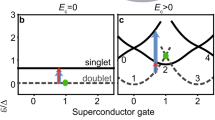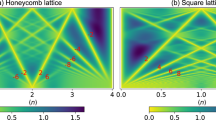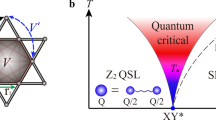Abstract
In quantum theory, indistinguishable particles in three-dimensional space behave in only two distinct ways. On interchange, their wavefunction maps either to itself if the particles are bosons, or to minus itself if they are fermions. In two dimensions, a more exotic possibility arises: on exchange of two particles known as anyons, the wavefunction acquires the phase  . Such fractional exchange statistics are normally regarded as the hallmark of strong correlations. Here, we describe a theoretical proposal for a system whose excitations are anyons with the exchange phase θ=π/4 and charge ±e/2, but at the same time can be built by filling a set of single-particle states of essentially non-interacting electrons. The system consists of an artificially structured type-II superconducting film adjacent to a two-dimensional electron gas in the integer quantum Hall regime with unit filling fraction. The proposed set-up enables manipulation of these anyons and could prove useful in schemes for fault-tolerant topological quantum computation.
. Such fractional exchange statistics are normally regarded as the hallmark of strong correlations. Here, we describe a theoretical proposal for a system whose excitations are anyons with the exchange phase θ=π/4 and charge ±e/2, but at the same time can be built by filling a set of single-particle states of essentially non-interacting electrons. The system consists of an artificially structured type-II superconducting film adjacent to a two-dimensional electron gas in the integer quantum Hall regime with unit filling fraction. The proposed set-up enables manipulation of these anyons and could prove useful in schemes for fault-tolerant topological quantum computation.
This is a preview of subscription content, access via your institution
Access options
Subscribe to this journal
Receive 12 print issues and online access
$209.00 per year
only $17.42 per issue
Buy this article
- Purchase on Springer Link
- Instant access to full article PDF
Prices may be subject to local taxes which are calculated during checkout



Similar content being viewed by others
References
Laughlin, R. B. Anomalous quantum Hall effect: An incompressible quantum fluid with fractionally charged excitations. Phys. Rev. Lett. 50, 1395–1399 (1983).
Arovas, D., Schrieffer, J. R. & Wilzcek, F. Fractional statistics and the quantum Hall effect. Phys. Rev. Lett. 53, 722–723 (1984).
Wen, X. G. Mean-field theory of spin-liquid states with finite energy gap and topological orders. Phys. Rev. Lett. 44, 2664–2672 (1991).
Kitaev, A. Yu. Fault-tolerant quantum computation by anyons. Ann. Phys. 303, 2–30 (2003).
Freedman, M., Nayak, C., Shtengel, K., Walker, K. & Wang, Z. A class of P,T-invariant topological phases of interacting electrons. Ann. Phys. 310, 428–492 (2004).
Kitaev, A. Yu. Anyons in an exactly solved model and beyond. Ann. Phys. 321, 2–111 (2006).
Su, W. P., Schrieffer, J. R. & Heeger, A. J. Solitons in polyacetylene. Phys. Rev. Lett. 42, 1698–1701 (1979).
Jackiw, R. & Rebbi, C. Solitons with fermion number 1/2. Phys. Rev. D 13, 3398–3409 (1976).
Hou, C.-Y., Chamon, C. & Mudry, C. Electron fractionalization in two-dimensional graphene-like structures. Phys. Rev. Lett. 98, 186809 (2007).
Bending, S. J., von Klitzing, K. & Ploog, K. Weak localization in a distribution of magnetic flux tubes. Phys. Rev. Lett. 65, 1060–1063 (1990).
Geim, A. K., Bending, S. J. & Grigorieva, I. V. Asymmetric scattering and diffraction of two-dimensional electrons at quantized tubes of magnetic flux. Phys. Rev. Lett. 69, 2252–2255 (1992).
Danckwerts, M., Goñi, A. R., Thomsen, C., Eberl, K. & Rojo, A. G. Enhanced vortex damping by eddy currents in superconductor-semiconductor hybrids. Phys. Rev. Lett. 84, 3702–3705 (2000).
Rammer, J. & Shelankov, A. L. Weak localization in inhomogeneous magnetic fields. Phys. Rev. B 36, 3135–3146 (1987).
Nielsen, M. & Hedegard, P. Two-dimensional electron transport in the presence of magnetic flux vortices. Phys. Rev. B 51, 7679–7699 (1995).
Berciu, M., Rappoport, T. G. & Janko, B. Manipulating spin and charge in magnetic semiconductors using superconducting vortices. Nature 435, 71–75 (2005).
Welp, U., Xiao, Z. L., Novosad, V. & Vlasko-Vlasov, V. K. Commensurability and strong vortex pinning in nanopatterned Nb films. Phys. Rev. B 71, 014505 (2005).
Wilczek, F. Quantum mechanics of fractional-spin particles. Phys. Rev. Lett. 49, 957–959 (1982).
Kirtley, J. R. et al. Direct imaging of integer and half-integer Josephson vortices in high-T c grain boundaries. Phys. Rev. Lett. 76, 1336–1339 (1996).
Tafuri, F., Kirtley, J. R., Medaglia, P. G., Orgiani, P. & Balestrino, G. Magnetic imaging of pearl vortices in artificially layered (Ba0.9Nd0.1CuO2+x)m/(CaCuO2)n systems. Phys. Rev. Lett. 92, 157006 (2004).
Bluhm, H., Sebastian, S. E., Guikema, J. W., Fisher, I. R. & Moler, K. A. Scanning Hall probe imaging of ErNi2B2C. Phys. Rev. B 73, 014514 (2006).
Gardner, B. W. et al. Manipulation of single vortices in YBa2Cu3O6.354 with a locally applied magnetic field. Appl. Phys. Lett. 80, 1010–1014 (2002).
Gardner, B. W. et al. Vortex-antivortex annihilation in underdoped YBa2Cu3O6.354 . Physica C 388–389, 725–726 (2003).
Moore, G. & Read, N. Nonabelions in the fractional quantum Hall effect. Nucl. Phys. B 360, 362–396 (1991).
Nayak, C. & Wilczek, F. 2n-quasihole states realize 2n−1-dimensional spinor braiding statistics in paired quantum Hall states. Nucl. Phys. B 479, 529–553 (1996).
Read, N. & Green, D. Paired states of fermions in two dimensions with breaking of parity and time-reversal symmetries and the fractional quantum Hall effect. Phys. Rev. B 61, 10267–10297 (2000).
Laughlin, R. B. Quantized Hall conductivity in two dimensions. Phys. Rev. B 23, 5632–5633 (1981).
Halperin, B. I. Quantized Hall conductance, current-carrying edge states, and the existence of extended states in a two-dimensional disordered potential. Phys. Rev. B 25, 2185–2190 (1982).
Wilczek, F. Fractional Statistics and Anyon Superconductivity (World Scientific, Singapore, 1990).
Peierls, R. Zur Theorie des Diamagnetismus von Leitungselektronen. Z. Physik 80, 763–791 (1933).
Das Sarma, S., Freedman, M. & Nayak, C. Topologically protected qubits from a possible non-abelian fractional quantum Hall state. Phys. Rev. Lett. 94, 166802 (2005).
Bonderson, P., Kitaev, A. & Shtengel, K. Detecting non-abelian statistics in the ν=5/2 fractional quantum Hall state. Phys. Rev. Lett. 96, 016803 (2006).
Willett, R. et al. Observation of an even-denominator quantum number in the fractional quantum Hall effect. Phys. Rev. Lett. 59, 1776–1780 (1987).
Krauth, H. in Handbook of Applied Superconductivity Vol. 1 (ed. Seeber, B.) (IOP, London, 1998).
Niu, H. J. & Hampshire, D. P. Disordered nanocrystalline superconducting PbMo6S8 with a very large upper critical field. Phys. Rev. Lett. 91, 027002 (2003).
Hoogenboom, B. W., Kugler, M., Revaz, B., Maggio-Aprile, I. & Fischer, Ø. Shape and motion of vortex cores in Bi2Sr2CaCu2O8+δ . Phys. Rev. B 62, 009179 (2000).
Bartosch, L., Balents, L. & Sachdev, S. Detecting the quantum zero-point motion of vortices in the cuprate superconductors. Ann. Phys. 321, 1528–1546 (2006).
Pearl, J. Current distribution in superconducting films carrying quantized fluxoids. Appl. Phys. Lett. 5, 65–66 (1964).
Tinkham, M. Introduction to Superconductivity (McGraw-Hill, New York, 1996).
Acknowledgements
The authors are indebted to M. Berciu and A. Vishwanath for some key suggestions and wish to thank I. Affleck, D. Fisher, D. Haldane, C. Kallin, A. Kitaev, K. Shtengel, D. Scalapino and Z. Tesanovic for stimulating discussions and correspondence. The work reported here was supported by NSERC, CIAR and the Killam Foundation.
Author information
Authors and Affiliations
Corresponding author
Rights and permissions
About this article
Cite this article
Weeks, C., Rosenberg, G., Seradjeh, B. et al. Anyons in a weakly interacting system. Nature Phys 3, 796–801 (2007). https://doi.org/10.1038/nphys730
Received:
Accepted:
Published:
Issue Date:
DOI: https://doi.org/10.1038/nphys730
This article is cited by
-
Realizing a 1D topological gauge theory in an optically dressed BEC
Nature (2022)
-
Hall conductance for open two-band system beyond rotating-wave approximation
Scientific Reports (2017)
-
Complex Vortex Configuration in a Disk with a Higher/Lower Critical Temperature Superconducting Geometrical Central Defect
Journal of Low Temperature Physics (2015)
-
Mechanics of individual isolated vortices in a cuprate superconductor
Nature Physics (2009)
-
A home for anyon?
Nature Physics (2007)



